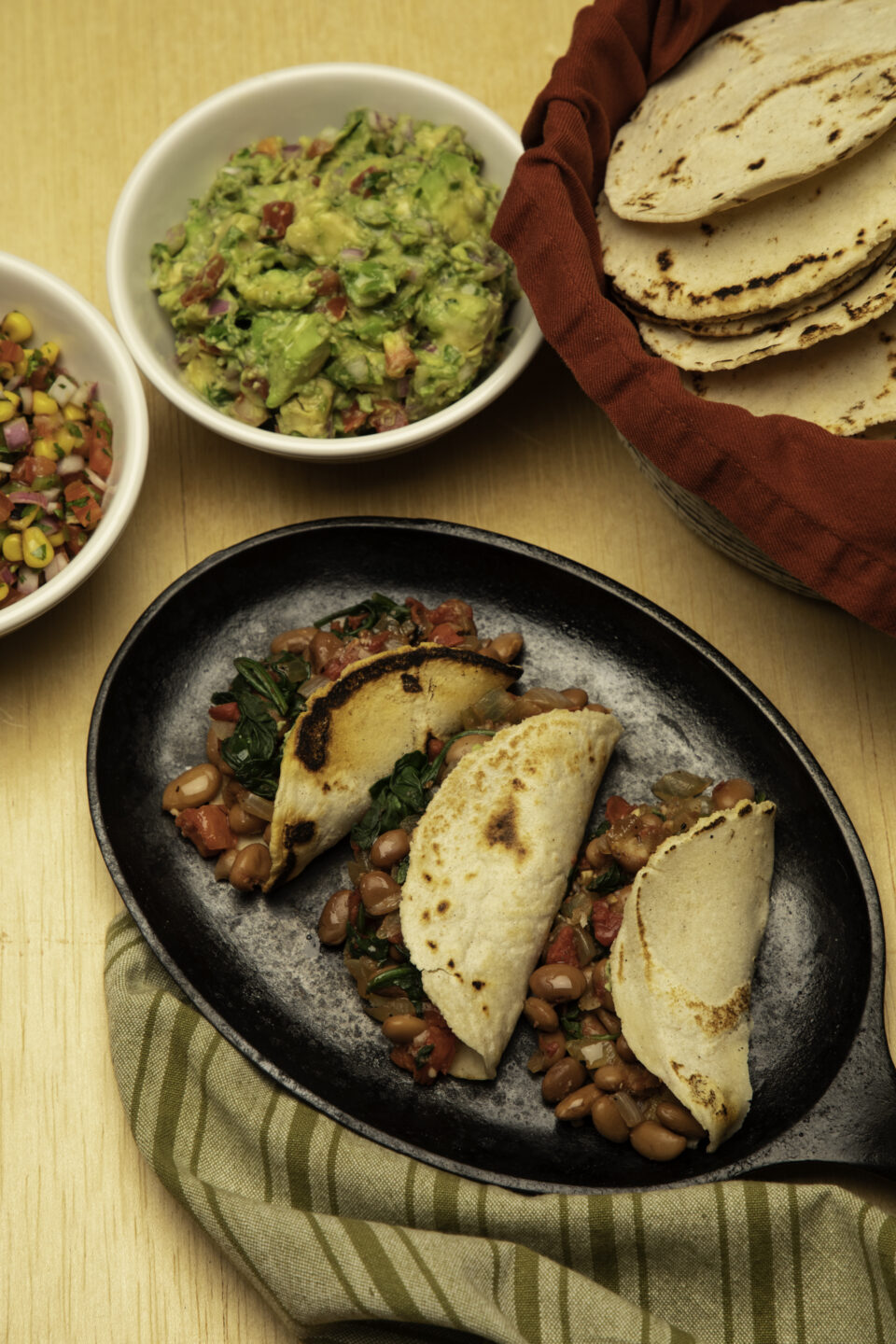| Meet Chef Lois Ellen Frank, Ph.D. We had the pleasure of talking with Dr. Frank about her work, food, and Native American cuisine. Read on and enjoy her recipe for Delicious Pinto Bean and Spinach Tacos. |  |
Please tell us a little about yourself and your work.
My name is Lois Ellen Frank, and I am a Santa Fe, New Mexico-based chef cooking alongside Chef Walter Whitewater at Red Mesa Cuisine, LLC, a small catering company specializing in Native American cuisine. We focus on Indigenous Cuisine and Cultural Education, and work on the revitalization of ancestral Native American cuisine. We incorporate a modern twist and prepare foods using ingredients focused on health and wellness. Together, we have been working with communities in the Southwest for more than 30 years. Our newest cookbook, Seed to Plate, Soil to Sky: Modern Plant Based Recipes Using Native American Ingredients, was released in the fall of 2023 and focuses on The Magic Eight, eight plants that Native Peoples shared with the world. We also work with the Physicians Committee for Responsible Medicine (PCRM) on The Power to Heal Diabetes: Food for Life in Indian Country program, which uses the ancestral Native American diet for health and wellness in Native American communities throughout the United States to re-indigenize, revitalize, and re-introduce healthy ancestral foods back the diet. (Learn more at www.nativepowerplate.org.)
Can you please discuss the re-indigenizing food movement in the Native American community? How can this promote better health and wellness?
By using healthy foods from the ancestral past, including The Magic Eight (corn, beans, squash, chiles, tomatoes, potatoes, vanilla, and cacao), and increasing the amount of plant-based foods in the current Standard American Diet (SAD), the Native American foods movement works towards reclaiming ancestral foods for wellness; revitalizing traditional cooking techniques and recipes associated with them; educating and teaching children, teens, college students, and adults about the importance of traditional foods and the role they play in health and wellness; developing well-rounded culinary professionals in both the theory and technique of cuisine; developing specialized workshops tailored toward individual and group needs that include (but are not limited to) health, nutrition, team-building, youth development, and technical skill enhancement, as well as other social and professional development; creating an awareness of traditional and contemporary Native American culinary customs and technologies that include concepts of sustainable agriculture, health, and nutrition; and emphasizing how the health benefits of an ancestral plant-based diet can improve health and connect community members to healthy ancestral foods.
Can you please tell us about The Magic Eight? What are they, and what is the history of these foods?
The Magic Eight are eight plants that Native Peoples gave to the world: corn, beans, squash, chiles, tomatoes, potatoes, vanilla, and cacao. Prior to 1492, these plants existed only in the Americas. Once these plants were introduced to cultures of the world outside of the Americas, their cuisines were changed forever. And these eight plants, now found in almost every cuisine all over the world, are inherently Native American, an important part of our cuisine, and the foundation to the foods we cook at Red Mesa Cuisine. Think about this: The Italians didn’t have the tomato until after 1492. The Irish didn’t have the potato. In Britain, they had fish, but no chips. The Russians didn’t have the potato, nor did they have distilled spirits from the potato. There were no chiles in any East Indian cuisine dishes, including curries, and no chiles existed in any Asian cuisines at all. As a matter of fact, chiles weren’t introduced into South Asia until the 1500s when they would come to dominate the world spice trade in the sixteenth century. Vanilla and cacao weren’t used in any confection dishes prior to 1492. The world cuisines as we know them today were completely different!
How were these Magic Eight foods used in Native American cuisine historically versus in modern-day cuisine?
These foods were used in a variety of ways. Corn, beans, and squash were (and still are) often served together. Chef Walter thinks of them as a family. They are grown together and eaten together. Chiles, tomatoes, and potatoes were also often used together in the past, as they are today, as their flavors work well together and they are nightshade plants. Vanilla and cacao are considered to be the sweet sisters and are often paired together. In our cookbook Seed to Plate, Soil to Sky, we have shared some very traditional ancestral recipes featuring these eight amazing plants and introduced some new and creative ways to eat them in both savory and sweet dishes.
Is there a way that local food systems can be better supported so more of these plants can become cultivated and accessible?
We are very blessed in New Mexico. There are lots of farmers in Northern New Mexico where I live, and they grow many varieties of corn, beans, squashes, chiles, tomatoes, and potatoes, so it is easy for someone living here to purchase many of these plants and incorporate them into their diets. It’s also easy to grow your own garden here, even in a small space. Buying from the local Santa Fe farmers market helps to support the farmers and perpetuate the growing of these important crops. And, more and more Native American communities are implementing gardens for their community members and growing traditional varieties of these amazing plants, making these foods accessible and affordable to those who really need them. Programs such as WIC, SNAP-Ed, and FDPIR are including New Mexico-grown produce as part of their distribution programs, and Chef Walter and I are working hard to teach people how to use the plants in delicious and nutritious dishes.
Are there other lesser-known plants that are used in Native American cuisine that you would like to highlight?
Native American cuisine is regional, so a plant that is common to one community in one region of the United States might not be common in another. It also depends on what grows in each region. For instance, wild rice grows in the lake regions and is a very important and sacred food to the communities living there. Where I live, wild plant foods play an important part of the diet. I love to eat wild lettuces and spinach, wild purslane, and edible flowers. There are many herbs from this region that play an important part in this cuisine––both wild and cultivated plants. I think the more plants, the better. I love plants, and Chef Walter and I try to honor the plants and eat seasonally when they are available. We also use culinary ash to increase the nutrients and minerals in some of our corn dishes.
What does Native American Heritage Month mean to you?
That’s a tough question. Food to me is medicine. I try to practice gratefulness and appreciation for the bounty of foods and plants in my life everyday––not just one month a year. But, if people can appreciate the plants that Native Americans shared with the world and honor the Native American contribution to the foods we eat every day, then that makes me happy. Many people are unaware of the contribution Native Peoples have made to the foods we eat each day, including corn, beans, squash, chiles, tomatoes, potatoes, vanilla, and cacao. When these foods are prepared in a healthy way and the Traditional Ecological knowledge (TEK) surrounding these plants is revitalized, then so is everything associated with them. And when people are fed these foods, they are nurtured, and the knowledge and importance of this ancestral knowledge is honored.
Delicious Pinto Bean and Spinach Tacos
|
This recipe, adapted from Seed to Plate, Soil to Sky, is a wonderful combination of fresh spinach greens sautéed with cooked beans. It is easy to make for a healthy and nutritious meal. I use organic spinach, which is now readily available, and if I don’t want to cook a whole pot of fresh beans, organic canned pinto beans from the grocery store.
|
 |
Heat a small cast iron skillet over high heat until hot.
Prepare the Roasted Garlic.
Heat a medium- to large-sized cast iron pan over medium-high heat until it is hot, then add the Roasted Garlic, tomatoes, and onion, and cook for 2 to 3 minutes, stirring constantly to prevent burning. Add the spinach, and cook for another 2 minutes. Then, add the pinto beans and a pinch of black pepper, and cook for 2 minutes, stirring constantly to prevent burning.
Serve in your favorite corn or flour tortillas. (I like this dish with either corn tortillas or gordita-sized flour tortillas.)
Top with freshly made pico de gallo salsa and homemade guacamole, if desired. Serve immediately.
Makes 6 tacos.
You can find Chef Lois Ellen Frank here.






